医护英语急救基础英语教学设计知识讲解
- 格式:doc
- 大小:16.00 KB
- 文档页数:4
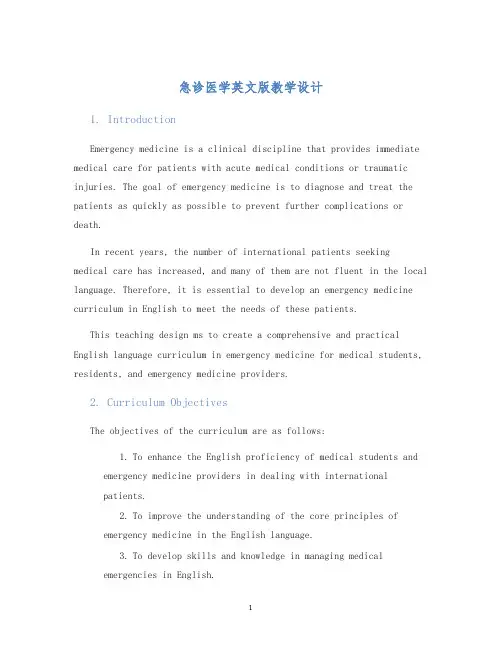
急诊医学英文版教学设计1. IntroductionEmergency medicine is a clinical discipline that provides immediate medical care for patients with acute medical conditions or traumatic injuries. The goal of emergency medicine is to diagnose and treat the patients as quickly as possible to prevent further complications or death.In recent years, the number of international patients seeking medical care has increased, and many of them are not fluent in the local language. Therefore, it is essential to develop an emergency medicine curriculum in English to meet the needs of these patients.This teaching design ms to create a comprehensive and practical English language curriculum in emergency medicine for medical students, residents, and emergency medicine providers.2. Curriculum ObjectivesThe objectives of the curriculum are as follows:1.To enhance the English proficiency of medical students andemergency medicine providers in dealing with internationalpatients.2.To improve the understanding of the core principles ofemergency medicine in the English language.3.To develop skills and knowledge in managing medicalemergencies in English.4.To promote cultural sensitivity and professionalism whencaring for international patients.3. Curriculum ComponentsThe curriculum is divided into four components:3.1. Language ProficiencyThis component focuses on improving the English proficiency of medical students and emergency medicine providers. The topics covered in this component include medical terminology, communication skills, and cross-cultural competence.3.2. Core Principles of Emergency MedicineThis component provides an overview of the core principles of emergency medicine. The topics covered in this component include triage, advanced life support, trauma management, and toxicology.3.3. Clinical Skills and KnowledgeThis component focuses on developing practical skills and knowledge in managing medical emergencies in English. The topics covered in this component include cardiac arrest, stroke, respiratory distress, and sepsis management.3.4. Cultural Sensitivity and ProfessionalismThis component ms to promote cultural sensitivity andprofessionalism when caring for international patients. The topics covered in this component include cultural awareness, ethics, and legal issues in emergency medicine.4. Teaching MethodsThe teaching methods used in this curriculum include didactic lectures, case-based discussions, simulation exercises, and clinical rotations.Didactic lectures are used to introduce core concepts, while case-based discussions are used to enhance critical thinking and problem-solving skills. Simulation exercises are used to provide hands-on experience in managing medical emergencies. Clinical rotations are used to apply the knowledge and skills learned in the classroom in a real clinical setting.5. EvaluationThe evaluation of the curriculum is carried out through written examinations, practical assessments, and feedback from students and emergency medicine providers.Written examinations are used to assess the knowledge and understanding of the core concepts of emergency medicine. Practical assessments are used to evaluate the application of skills and knowledge in managing medical emergencies. Feedback from students and emergency medicine providers is collected to evaluate the effectiveness of the curriculum and to identify areas for improvement.6. ConclusionIn conclusion, this teaching design provides a comprehensive and practical English language curriculum in emergency medicine for medical students, residents, and emergency medicine providers. The curriculum isdesigned to enhance the English proficiency of the learners, improve understanding of the core principles of emergency medicine, develop skills and knowledge in managing medical emergencies in English, and promote cultural sensitivity and professionalism when caring for international patients. The teaching methods used in the curriculum m to provide a comprehensive and effective learning experience for the learners. The evaluation of the curriculum ms to assess the effectiveness of the curriculum and to identify areas for further improvement.。
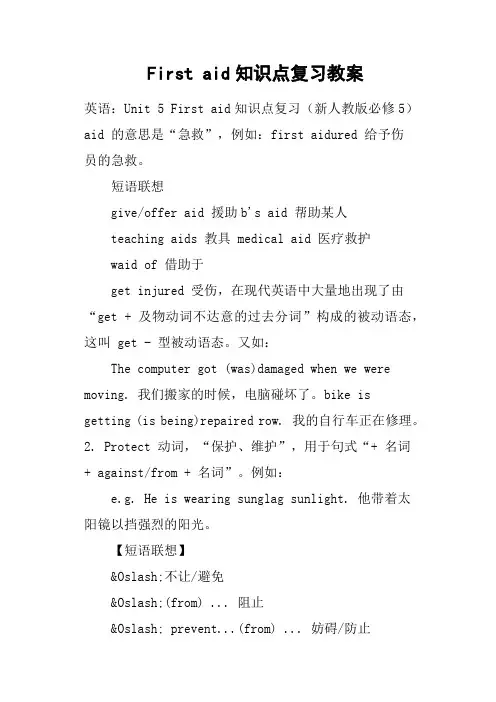
First aid知识点复习教案英语:Unit 5 First aid知识点复习(新人教版必修5)aid 的意思是“急救”,例如:first aidured 给予伤员的急救。
短语联想give/offer aid 援助b's aid 帮助某人teaching aids 教具 medical aid 医疗救护waid of 借助于get injured 受伤,在现代英语中大量地出现了由“get + 及物动词不达意的过去分词”构成的被动语态,这叫 get - 型被动语态。
又如:The computer got (was)damaged when we were moving. 我们搬家的时候,电脑碰坏了。
bike isgetting (is being)repaired row. 我的自行车正在修理。
2. Protect 动词,“保护、维护”,用于句式“+ 名词+ against/from + 名词”。
例如:e.g. He is wearing sunglag sunlight. 他带着太阳镜以挡强烈的阳光。
【短语联想】Ø不让/避免Ø(from) ... 阻止Ø prevent...(from) ... 妨碍/防止Ø disabl使……失去(能力/资格)Ø sav挽救、拯救3.depend on 取决于。
例如:e.g. The amount you pay depends on where you live. 你付多少取决于你住哪里。
词义拓展depend on 依靠,依赖:His family depend他的一家人全靠他养活。
依赖,信任:We are depending on youb by Friday. 我们相信你在星期五前能完成这项工作。
4. squeeze 动词,意思是“榨取”、“挤出”,例如:squeeze an orange 榨橘子常用句式squeeze + 名词 + out(of/from) + 名词,例如:e.g. Those blackmailded to squu那些勒索者打算向他榨取更多的钱。
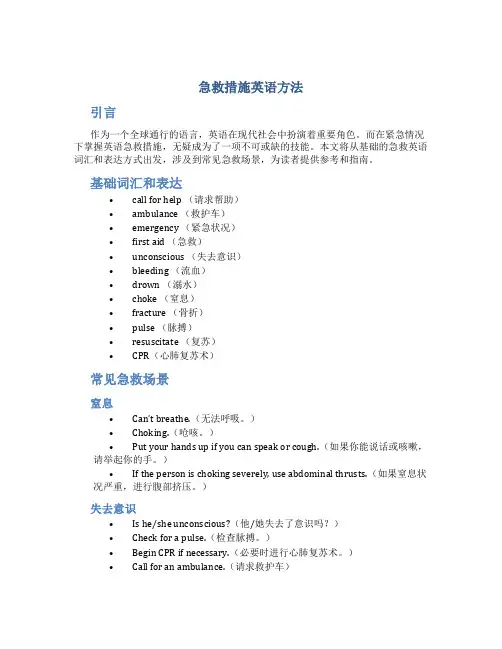
急救措施英语方法引言作为一个全球通行的语言,英语在现代社会中扮演着重要角色。
而在紧急情况下掌握英语急救措施,无疑成为了一项不可或缺的技能。
本文将从基础的急救英语词汇和表达方式出发,涉及到常见急救场景,为读者提供参考和指南。
基础词汇和表达•call for help (请求帮助)•ambulance (救护车)•emergency (紧急状况)•first aid (急救)•unconscious (失去意识)•bleeding (流血)•drown (溺水)•choke (窒息)•fracture (骨折)•pulse (脉搏)•resuscitate (复苏)•CPR(心肺复苏术)常见急救场景窒息•Can’t breathe.(无法呼吸。
)•Choking.(呛咳。
)•Put your hands up if you can speak or cough.(如果你能说话或咳嗽,请举起你的手。
)•If the person is choking severely, use abdominal thrusts.(如果窒息状况严重,进行腹部挤压。
)失去意识•Is he/she unconscious?(他/她失去了意识吗?)•Check for a pulse.(检查脉搏。
)•Begin CPR if necessary.(必要时进行心肺复苏术。
)•Call for an ambulance.(请求救护车)骨折•Is there a fracture?(是否有骨折?)•Be careful not to move the person.(小心不要让人动。
)•Call for an ambulance.(请求救护车。
)•Elevate the injured part and apply ice.(抬高受伤部位并冰敷。
)糖尿病低血糖•Is he/she diabetic?(他/她是否患糖尿病?)•Does he/she have a history of low blood sugar?(他/她是否有低血糖的历史?)•Give him/her something sweet, like candy or juice.(给他/她一些甜食,如糖果或果汁。
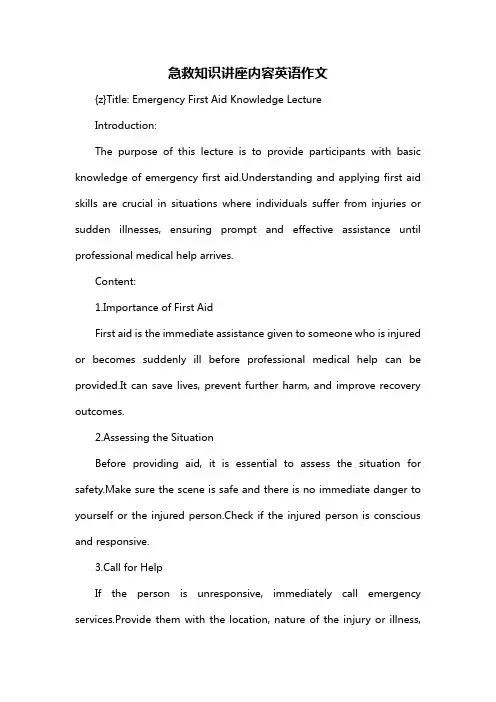
急救知识讲座内容英语作文{z}Title: Emergency First Aid Knowledge LectureIntroduction:The purpose of this lecture is to provide participants with basic knowledge of emergency first aid.Understanding and applying first aid skills are crucial in situations where individuals suffer from injuries or sudden illnesses, ensuring prompt and effective assistance until professional medical help arrives.Content:1.Importance of First AidFirst aid is the immediate assistance given to someone who is injured or becomes suddenly ill before professional medical help can be provided.It can save lives, prevent further harm, and improve recovery outcomes.2.Assessing the SituationBefore providing aid, it is essential to assess the situation for safety.Make sure the scene is safe and there is no immediate danger to yourself or the injured person.Check if the injured person is conscious and responsive.3.Call for HelpIf the person is unresponsive, immediately call emergency services.Provide them with the location, nature of the injury or illness,and any other relevant information.4.Airway ManagementEnsure the airway is clear and open.Tilt the person"s head back and lift their chin to align the airway.If the person is not breathing or only gasping, start cardiopulmonary resuscitation (CPR).5.Breathing and CPRIf the person is not breathing, give two initial rescue breaths.If the person does not breathe or only gasps, perform chest compressions.The ratio of compressions to breaths is 30:2.Continue CPR until help arrives or the person starts showing signs of life.6.Bleeding ControlTo control bleeding, apply direct pressure to the wound with a clean cloth or dressing.Elevate the injured limb if possible.If bleeding continues, apply additional pressure and seek medical help.7.Fractures and SprainsFor suspected fractures or sprains, immobilize the injured area using a splint or padding.Avoid moving the person unless they are in immediate danger.8.ShockSigns of shock include pale skin, rapid breathing, confusion, and dizziness.Keep the person calm and lying down.Cover them with a blanket and monitor their condition until medical help arrives.9.PoisoningIf poisoning is suspected, do not make the person vomit.Collect any contaminated items and inform emergency services.Provide information about the substance ingested or absorbed.Conclusion:This lecture has provided participants with an overview of emergency first aid techniques.By understanding and practicing these skills, individuals can confidently provide assistance during emergencies, potentially saving lives and minimizing further harm.Regular first aid training and certification can enhance these skills and ensure preparedness for any situation.。
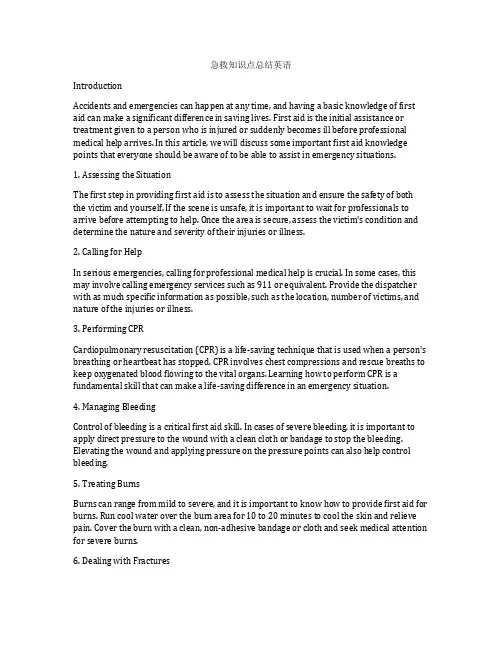
急救知识点总结英语IntroductionAccidents and emergencies can happen at any time, and having a basic knowledge of first aid can make a significant difference in saving lives. First aid is the initial assistance or treatment given to a person who is injured or suddenly becomes ill before professional medical help arrives. In this article, we will discuss some important first aid knowledge points that everyone should be aware of to be able to assist in emergency situations.1. Assessing the SituationThe first step in providing first aid is to assess the situation and ensure the safety of both the victim and yourself. If the scene is unsafe, it is important to wait for professionals to arrive before attempting to help. Once the area is secure, assess the victim's condition and determine the nature and severity of their injuries or illness.2. Calling for HelpIn serious emergencies, calling for professional medical help is crucial. In some cases, this may involve calling emergency services such as 911 or equivalent. Provide the dispatcher with as much specific information as possible, such as the location, number of victims, and nature of the injuries or illness.3. Performing CPRCardiopulmonary resuscitation (CPR) is a life-saving technique that is used when a person's breathing or heartbeat has stopped. CPR involves chest compressions and rescue breaths to keep oxygenated blood flowing to the vital organs. Learning how to perform CPR is a fundamental skill that can make a life-saving difference in an emergency situation.4. Managing BleedingControl of bleeding is a critical first aid skill. In cases of severe bleeding, it is important to apply direct pressure to the wound with a clean cloth or bandage to stop the bleeding. Elevating the wound and applying pressure on the pressure points can also help control bleeding.5. Treating BurnsBurns can range from mild to severe, and it is important to know how to provide first aid for burns. Run cool water over the burn area for 10 to 20 minutes to cool the skin and relieve pain. Cover the burn with a clean, non-adhesive bandage or cloth and seek medical attention for severe burns.6. Dealing with FracturesIn the event of a bone fracture, it is important to immobilize the injured area to prevent further damage. Use a splint or a support to immobilize the affected area, and seek professional medical help as soon as possible.7. Providing First Aid for ChokingChoking occurs when a person's airway becomes blocked, cutting off their ability to breathe. The Heimlich maneuver is a first aid technique used to dislodge an object stuck in the throat, and it is important to know how to perform this procedure in case of an emergency.8. Recognizing Signs of StrokeStroke is a life-threatening condition that occurs when the blood supply to the brain is interrupted. Knowing the signs and symptoms of a stroke, such as sudden numbness, severe headache, and difficulty speaking, can help in providing timely first aid and seeking medical help.9. Managing ShockShock is a life-threatening condition that occurs when the body does not get enough blood flow. Providing first aid for shock involves laying the person on their back, elevating their legs, and keeping them warm with a blanket or jacket until professional help arrives.10. Carrying Out First Aid for Heart AttacksA heart attack occurs when the blood flow to the heart is blocked, and prompt first aid can help save a person's life. Recognizing the signs of a heart attack, such as chest pain, shortness of breath, and nausea, and seeking immediate medical help is crucial.ConclusionHaving a basic understanding of first aid can make a significant difference in emergency situations, and it is important for everyone to have some knowledge of lifesaving techniques. From assessing the situation to performing CPR and managing various medical emergencies, being aware of first aid knowledge points can help save lives in critical situations. It is also important to stay updated with first aid training and certification as it can give the skills and confidence needed to respond to emergencies effectively. Remember, taking the time to learn first aid could make a significant difference when it comes to saving a life.。
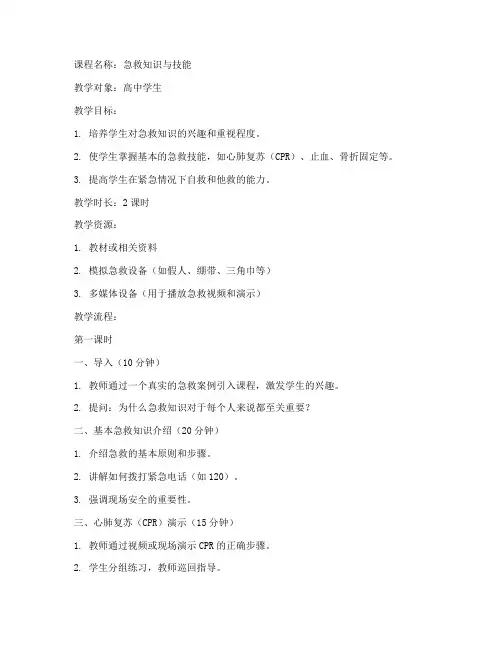
课程名称:急救知识与技能教学对象:高中学生教学目标:1. 培养学生对急救知识的兴趣和重视程度。
2. 使学生掌握基本的急救技能,如心肺复苏(CPR)、止血、骨折固定等。
3. 提高学生在紧急情况下自救和他救的能力。
教学时长:2课时教学资源:1. 教材或相关资料2. 模拟急救设备(如假人、绷带、三角巾等)3. 多媒体设备(用于播放急救视频和演示)教学流程:第一课时一、导入(10分钟)1. 教师通过一个真实的急救案例引入课程,激发学生的兴趣。
2. 提问:为什么急救知识对于每个人来说都至关重要?二、基本急救知识介绍(20分钟)1. 介绍急救的基本原则和步骤。
2. 讲解如何拨打紧急电话(如120)。
3. 强调现场安全的重要性。
三、心肺复苏(CPR)演示(15分钟)1. 教师通过视频或现场演示CPR的正确步骤。
2. 学生分组练习,教师巡回指导。
四、互动问答(10分钟)1. 教师提问关于急救的知识点,学生回答。
2. 学生之间互相提问,增进对急救知识的理解。
第二课时一、止血与包扎技巧(20分钟)1. 讲解如何正确进行止血和包扎。
2. 学生分组练习止血和包扎技巧,教师指导。
二、骨折固定与搬运(15分钟)1. 介绍骨折固定和搬运的正确方法。
2. 学生分组练习,教师指导。
三、现场模拟演练(20分钟)1. 学生分组进行现场模拟演练,包括拨打急救电话、进行CPR、止血和包扎、骨折固定等。
2. 教师观察并给予反馈。
四、总结与反思(10分钟)1. 教师总结本节课的主要内容。
2. 学生分享学习心得,提出疑问。
教学评价:1. 学生对急救知识的掌握程度。
2. 学生在模拟演练中的表现。
3. 学生对急救知识的兴趣和重视程度。
课后作业:1. 回顾本节课所学内容,完成一份急救知识笔记。
2. 邀请家人或朋友一起学习急救知识,共同提高自救和他救的能力。
备注:1. 教师应根据学生的实际情况调整教学内容和进度。
2. 在进行模拟演练时,确保学生的安全。
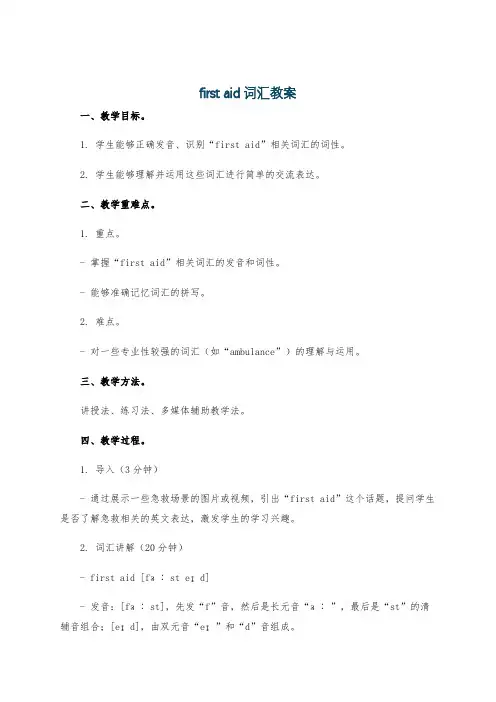
first aid词汇教案一、教学目标。
1. 学生能够正确发音、识别“first aid”相关词汇的词性。
2. 学生能够理解并运用这些词汇进行简单的交流表达。
二、教学重难点。
1. 重点。
- 掌握“first aid”相关词汇的发音和词性。
- 能够准确记忆词汇的拼写。
2. 难点。
- 对一些专业性较强的词汇(如“ambulance”)的理解与运用。
三、教学方法。
讲授法、练习法、多媒体辅助教学法。
四、教学过程。
1. 导入(3分钟)- 通过展示一些急救场景的图片或视频,引出“first aid”这个话题,提问学生是否了解急救相关的英文表达,激发学生的学习兴趣。
2. 词汇讲解(20分钟)- first aid [fɜːst eɪd]- 发音:[fɜːst],先发“f”音,然后是长元音“ɜː”,最后是“st”的清辅音组合;[eɪd],由双元音“eɪ”和“d”音组成。
- 词性:名词短语,意为“急救”。
例如:Everyone should learn some first aid knowledge.(每个人都应该学习一些急救知识。
)- aid [eɪd]- 发音:[eɪd],双元音“eɪ”加上“d”音。
- 词性:可作名词和动词。
- 名词:意为“援助;帮助;助手”。
例如:With the aid of my friends, I finished the work on time.(在我朋友们的帮助下,我按时完成了工作。
)- 动词:意为“帮助;援助;有助于”。
例如:We should aid those in need.(我们应该帮助那些有需要的人。
)- injury ['ɪndʒəri]- 发音:['ɪndʒəri],先发“ɪn”音,然后是“dʒ”音(类似汉语的“机”),再发“ə”音,最后是“ri”音。
- 词性:名词,意为“伤害;损害”。
例如:He got a serious injury in the accident.(他在事故中受了重伤。
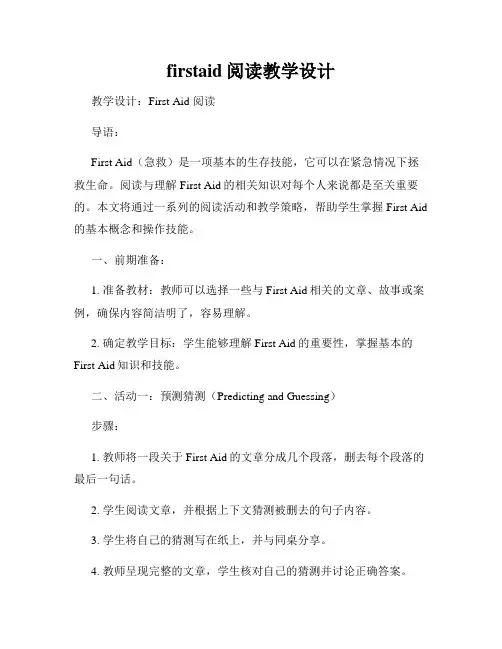
firstaid阅读教学设计教学设计:First Aid 阅读导语:First Aid(急救)是一项基本的生存技能,它可以在紧急情况下拯救生命。
阅读与理解First Aid的相关知识对每个人来说都是至关重要的。
本文将通过一系列的阅读活动和教学策略,帮助学生掌握First Aid 的基本概念和操作技能。
一、前期准备:1. 准备教材:教师可以选择一些与First Aid相关的文章、故事或案例,确保内容简洁明了,容易理解。
2. 确定教学目标:学生能够理解First Aid的重要性,掌握基本的First Aid知识和技能。
二、活动一:预测猜测(Predicting and Guessing)步骤:1. 教师将一段关于First Aid的文章分成几个段落,删去每个段落的最后一句话。
2. 学生阅读文章,并根据上下文猜测被删去的句子内容。
3. 学生将自己的猜测写在纸上,并与同桌分享。
4. 教师呈现完整的文章,学生核对自己的猜测并讨论正确答案。
5. 学生讨论文章中哪些地方可以进一步解释或扩展。
三、活动二:交际阅读(Interactive Reading)步骤:1. 教师备足First Aid相关短语和词汇的卡片,例如:“apply pressure”(压迫止血),“perform CPR”(进行心肺复苏)等。
2. 学生分成小组,教师分发一篇与First Aid相关的文章。
3. 学生阅读文章并标出不了解的单词和短语。
4. 学生根据自己的理解,使用卡片上的短语和词汇填写文章中的空白处。
5. 不同小组之间分享答案,教师纠正并解释正确答案。
四、活动三:信息交流(Information Exchange)步骤:1. 教师将一份First Aid相关的文章分成若干段落,并在每个段落末尾加上几个问题。
2. 学生分成小组,每个小组负责阅读并回答一个段落末尾的问题。
3. 学生互相交流各自的答案,并对不同答案进行讨论。
4. 教师引导学生就答案进行辩论,鼓励学生提供合理的解释和证据。
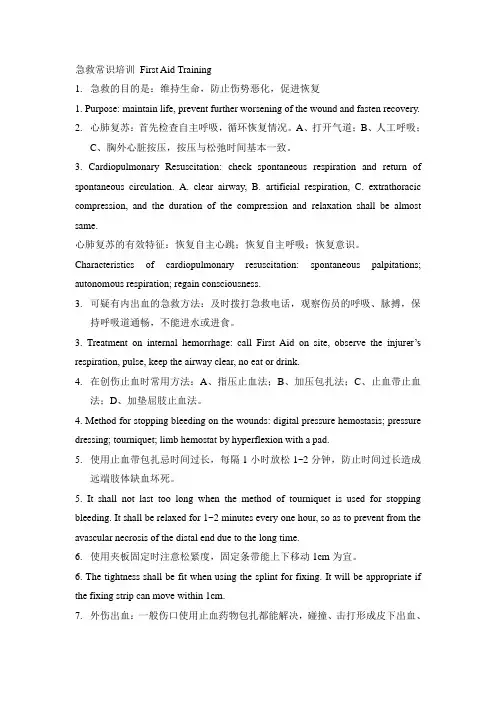
急救常识培训First Aid Training1.急救的目的是:维持生命,防止伤势恶化,促进恢复1. Purpose: maintain life, prevent further worsening of the wound and fasten recovery.2.心肺复苏:首先检查自主呼吸,循环恢复情况。
A、打开气道;B、人工呼吸;C、胸外心脏按压,按压与松弛时间基本一致。
3. Cardiopulmonary Resuscitation: check spontaneous respiration and return of spontaneous circulation. A. clear airway, B. artificial respiration, C. extrathoracic compression, and the duration of the compression and relaxation shall be almost same.心肺复苏的有效特征:恢复自主心跳;恢复自主呼吸;恢复意识。
Characteristics of cardiopulmonary resuscitation: spontaneous palpitations; autonomous respiration; regain consciousness.3.可疑有内出血的急救方法:及时拨打急救电话,观察伤员的呼吸、脉搏,保持呼吸道通畅,不能进水或进食。
3. Treatment on internal hemorrhage: call First Aid on site, observe the injurer’s respiration, pulse, keep the airway clear, no eat or drink.4.在创伤止血时常用方法:A、指压止血法;B、加压包扎法;C、止血带止血法;D、加垫屈肢止血法。
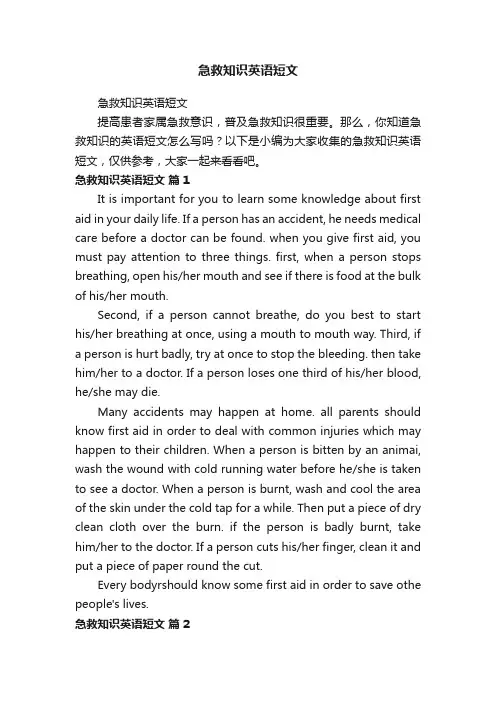
急救知识英语短文急救知识英语短文提高患者家属急救意识,普及急救知识很重要。
那么,你知道急救知识的英语短文怎么写吗?以下是小编为大家收集的急救知识英语短文,仅供参考,大家一起来看看吧。
急救知识英语短文篇1It is important for you to learn some knowledge about first aid in your daily life. If a person has an accident, he needs medical care before a doctor can be found. when you give first aid, you must pay attention to three things. first, when a person stops breathing, open his/her mouth and see if there is food at the bulk of his/her mouth.Second, if a person cannot breathe, do you best to start his/her breathing at once, using a mouth to mouth way. Third, if a person is hurt badly, try at once to stop the bleeding. then take him/her to a doctor. If a person loses one third of his/her blood, he/she may die.Many accidents may happen at home. all parents should know first aid in order to deal with common injuries which may happen to their children. When a person is bitten by an animai, wash the wound with cold running water before he/she is taken to see a doctor. When a person is burnt, wash and cool the area of the skin under the cold tap for a while. Then put a piece of dry clean cloth over the burn. if the person is badly burnt, take him/her to the doctor. If a person cuts his/her finger, clean it and put a piece of paper round the cut.Every bodyrshould know some first aid in order to save othe people's lives.急救知识英语短文篇2It is important for you to learn some knowledge about first aid in your daily life. If a person has an accident, he needs medical care before a doctor can be found. When you give first aid, you must pay attention to three things. First, when a person stops breathing, open his/her mouth and see if there is food at the bulk of his/her mouth. Second, if a person cannot breathe, do you best to start his/her breathing at once, using a mouth to mouth way. Third, if a person is hurt badly, try at once to stop the bleeding. Then take him/her to a doctor. If a person loses one third of his/her blood, he/she may die.Many accidents may happen at home. All parents should know first aid in order to deal with common injuries which may happen to their children. When a person is bitten by an animai, wash the wound with cold running water before he/she is taken to see a doctor. When a person is burnt, wash and cool the area of the skin under the cold tap for a while. Then put a piece of dry clean cloth over the burn. If the person is (关于桂花的作文)badly burnt, take him/her to the doctor. If a person cuts his/her finger, clean it and put a piece of paper round the cut. Every bodyrshould know some first aid in order to save othe people's lives.急救知识英语短文篇3"Green card" nickname (because of the color) of the United States Permanent Resident Card,an identification document issued by the United States of America affording non-citizens of that country some of the rights its citizens enjoy,sometimes with the prospect of naturalization.A United States Permanent Resident Card,also known as a green card,is an identification card attesting to the permanent resident status of an alien in the United States of America.Greencard also refers to an immigration process of becoming a permanent resident.The green card serves as proof that its holder,a Lawful Permanent Resident (LPR),has been officially granted immigration benefits,which include permission to reside and take employment in the USA.The holder must maintain permanent resident status,and can be removed from the US if certain conditions of this status are not met.Green cards were formerly issued by the Immigration and Naturalization Service (INS).That agency has been absorbed into and replaced by the Bureau of Citizenship and Immigration Services (BCIS),part of the Department of Homeland Security (DHS).Shortly after re-organization BCIS was renamed to U.S.Citizenship and Immigration Services.急救知识英语短文篇4My name is li hua, and the most impressive thing of my life came to my life yesterday. When I walked near by a lake with my friend, he was falling into the lake, and I was so worried. I did't know how to swim, but I had to save my friend's live. I was shouting and asking someone to help.After that, the most impressive thing happened which was a young solder that jump into the lake without thinking, swimmed to the palace where my friend were, and got him out of the lake. After the young solder checked if there was nothing wrong with my friend, he went away. In conclusion, this young solder is the one who i respect a lot!。

话题语言应用——急救编稿:牛新阁审稿:王春霞语言积累交际用语用于指示(Giving instructions)的句型:Now listen carefully .... 现在认真听着.......Follow these instructions. 按说明做。
Watch out for .... 注意/当心.......Look out for ... and .... 密切注意......然后......Don’t ... because .... 不要......,因为......Make sure that .... 要确定(保)......Take care to .... 当心......If it is ... go to the hospital. 如果......,就去医院。
Be careful (not) to .... 小心(不)要......Mind you do / don’t .... 留心你(不)要......Cover ... with .... 用......盖上Never .... 一定不要......It’s better to do ... 做......更好。
话题词句1. 有关危急事件和疾病的词汇:emergency 紧急事件bites and scratches 咬伤和抓伤bleeding 出血,流血broken bones 骨折sprain 扭伤 a sprained ankle 脚踝扭伤a nosebleed 鼻出血choking 窒息snake bites 蛇咬伤insect stings and bites 虫咬伤bruise 瘀伤, 擦伤burns 烧伤eye/ head/tooth injuries 眼部/头部/牙部受伤fever 发烧frostbite 冻伤heat illness 中暑vomiting 呕吐electric shock 触电;电休克sunburn 晒伤fall ill 生病bleed 流血swell/ swelled/ swollen 肿胀mildly/extremely painful 微/极痛watery surface 表层渗液get infected被感染blister 水泡pressure 压力2. 有关急救的词汇:ambulance 救护车first aid 急救ointment 药膏,油膏treat 治疗apply 涂,敷【高清课堂:Unit 5语言应用What should a first-aid kit include?】What should a first-aid kit include? 急救包要有什么?Basic supplies基本用品:adhesive tape 胶带antibiotic ointment 抗菌软膏bandages 绷带instant cold packs 速冻冰袋cotton balls 棉签latex gloves 橡胶手套gauze 纱布scissors剪刀tweezers 镊子needle 针soap 香皂thermometer 温度计■3. 有关身体部位的词汇:skin 皮肤organ 器官tissue (生物)组织ankle 踝(关节)wrist 手腕throat 喉咙nerve 神经【高清课堂:Unit 5语言应用Making an Emergency Medical Call】4. Making an Emergency Medical Call 急救电话Operator: Emergency operator. State(陈述) your emergency.Dirk: We need an ambulance right away.Operator: What is your name?Dirk: Dirk. Dirk Omora.Operator: Can you tell me what happened?Dirk: There was a car accident.Operator: Where are you?Dirk: I’m not sure. I was driving in my car when I saw the pileup(连环相撞). I’m somewhere on Blossom Road. Can you trace(追踪)my location(位置)?Operator: Yes, we’ll try to do that. Can you see if anyone is hurt?Dirk: One of the drivers is lying on the ground unconscious(失去知觉的) and the other one is bleeding. There’s someone trapped(困在) in the back of her car, too. We need to rescue her before the car explodes(爆炸)! I’m going to see if I can help.Operator: Sir, I need you to stay on the line(保持在线). I’m sending an ambulance right now and they’ll have the Jaws of Life and other equipment to do the job. The paramedics (医护人员)will be there very soon.Dirk: Okay, but hurry. ■注:Jaws of Life(救生颚):一种水压驱动的工具,用于从事故车辆中救出生者。
人教版(2019)选择性必修第二册Unit 5 First AidLearning About Language本节课是人教版(2019)选择性必修第二册Unit 5 First Aid Learning About Language课程的教学分析如下:教材分析:本节课主要内容是关于急救的相关词汇和短语的学习。
教材包括了一篇阅读材料和几个练习部分。
阅读材料介绍了几个身体部位的受伤情况,以及相关的急救方法。
教学目标:1. 知识与理解:学生能够掌握相关的急救词汇和短语。
2. 技能与能力:学生能够运用所学的知识,描述不同的受伤情况,并提供相应的急救方法。
3. 情感态度和价值观:培养学生对急救知识的重视和应对突发情况的能力。
教学重点:1. 学习相关的词汇和短语,如bleeding, fractured, unconscious等。
2. 学习如何描述不同的受伤情况,并提供相应的急救方法。
3. 学习如何运用所学的知识,进行情景交际和信息交流。
教学难点:1. 学生对一些专业的急救词汇的理解和正确使用。
2. 学生对一些情景交际的应对能力的培养。
学情分析:学生是高二的学生,他们已经具备一定的英语基础。
对急救方面的知识可能了解不够多,有一定的学习兴趣,但可能对一些专业术语和表达方式并不熟悉。
因此,需要通过具体的例子和实践运用来提高学生的学习兴趣和参与度。
教学策略:1. 创设语言环境:通过创设与急救相关的语言环境,引发学生的学习兴趣,提高他们对急救知识的重视。
2. 激发学生的兴趣:通过选择具有足够吸引力的素材和活动,激发学生的学习兴趣。
3. 互动交流:通过小组合作,情景模拟等互动形式,提高学生的参与度并培养他们的应对突发情况的能力。
4. 反馈和评价:充分利用教学资源和技术手段,及时给予学生反馈和评价,帮助他们及时发现和解决问题。
教学方法:1. 讨论和合作学习:通过学生之间的小组合作,讨论和分享他们对急救知识的理解和应用。
教会你如何做急救:高中英语Unit5FirstAid复习教案As a responsible citizen, it's always important to learn how to provide first aid in times of need. You never know when an emergency can happen, and it's better to be prepared than to regret later. The First Aid unit in high school is an essential module that gives students an opportunity to learn basic life-saving skills. In this article, we'll guide you through the key highlights of the First Aid unit and teach you how to be better prepared for any emergency situation.Lesson 1: Introduction to First AidThe first lesson in the First Aid unit is an introduction to first aid. In this lesson, students learn about the purpose and importance of first aid. The key takeaways from this lesson include:- First aid is the initial medical attention given to a sick or injured person before professional medical care arrives.- The purpose of first aid is to save lives, prevent further injury, and promote recovery.- It's crucial to remain calm, act quickly, and providethe appropriate care during an emergency situation.Lesson 2: Basic Life SupportThe second lesson in the First Aid unit is about basiclife support. In this lesson, students learn how to provide cardiopulmonary resuscitation (CPR) and the Heimlich maneuver. The key takeaways from this lesson include:- CPR is a lifesaving technique that involves chest compressions and mouth-to-mouth breathing to restorebreathing and circulation in a person who has stoppedbreathing or whose heart has stopped beating.- The Heimlich maneuver is a technique used to dislodgean object blocking the airway of a choking person.Lesson 3: Bleeding and Wound CareThe third lesson in the First Aid unit is about bleeding and wound care. In this lesson, students learn how to treat various types of wounds such as:- Abrasions (scrapes)- Lacerations (cuts)- Punctures (stab wounds)The key takeaways from this lesson include:- It's important to practice good hygiene and use proper equipment such as gloves and bandages when providing wound care.- Different types of wounds require different types of treatment. For example, puncture wounds require immediate medical attention, while abrasions can be treated with basic wound care.Lesson 4: ShockThe fourth lesson in the First Aid unit is about shock. In this lesson, students learn about the symptoms of shock and how to provide first aid to someone who is in shock. The key takeaways from this lesson include:- Shock is a life-threatening condition that occurs when the body isn't getting enough oxygen.- Symptoms of shock include rapid breathing, rapid pulse, confusion or unresponsiveness, and cold, clammy skin.- To provide first aid to someone who is in shock, it's important to keep them warm, elevate their legs, and seek immediate medical attention.Lesson 5: BurnsThe fifth lesson in the First Aid unit is about burns. In this lesson, students learn about the different types ofburns and how to provide first aid for each type. The key takeaways from this lesson include:- Burns can be caused by heat, chemicals, electricity, or radiation.- The severity of a burn is determined by its depth and size.- To provide first aid for a burn, it's important to remove the person from the source of the burn, cool theburned area with water, cover the burn with a sterile bandage, and seek medical attention if necessary.ConclusionThe First Aid unit in high school is an essential module that equips students with life-saving skills. By learning thebasics of first aid, you can provide immediate care to someone in need and potentially save their life. As a responsible citizen, it's important to be prepared for any emergency situation. So, take the lessons from this article to heart, and remember to stay calm, act quickly, and provide the necessary care during an emergency situation.。
医护英语《急救基础英语》教学设计
课题:急救基础英语 (ABC English for First Aid)
授课教师:江晓东 教学部门:公共基础部英语教研室
授课学科:英语 适用专业:护理各专业
授课课程: 英语 适用对象:2012级护理专业各班级
该课体现的基本教育理念:医药类高职高专英语教学应在尊重学
生英语基础学力和个体差异的基础上,突出医护专业特色,强化为医
护专业人才培养服务和为学生后续发展服务的意识。在设计思路上,
力图把英语课堂的基础性、职业性和人文性整合贯通。其教学特色为
目标可达、内容实用、方法多样,提高学生职业场景英语语言技能,
促进学生探索和改善英语学习策略,激发学生了解多元文化的兴趣。
一、教学背景
进入第二学期的护理专业学生,70%左右的学生已经达到《高职
高专教育英语课程教学基本要求》的相关规定。特别是在词汇和读写
能力方面,大部分学生已经具备高等学校英语应用能力测试A级或B
级考试的要求。但是,对于《基本要求》中所述“在业务活动中进行
简单的口头和书面交流”的能力要求还有待提高。
从学生英语学习动机看,由于英语教学实效和个人学习偏好等
因素影响,部分学生逐渐丧失英语学习的兴趣,开始把主要学习时间
和精力转向专业科目和其它科目的学习。在英语学习者中,英语学习
的动机也逐渐显现多元化,极少数学生为出国留学和务工学习英语,
部分学生为“专升本”考试学习英语,一般学生的英语学习动机为应
付期末英语考试或补考。不过,尚有相当大的一部分学生认为英语学
习需继续保持,理由为工作需要、职称外语考试、教育未来子女等。
从职业需求分析来看,英语教学应更加注重职业场景交际能力培
养。高职高专护理专业人才培养一般针对某区域基层卫生人才岗位,
但是也有部分护理专业学生毕业后去向大中城市和沿海地区。通过对
这些护理岗位的英语需求分析发现,简单的医护英语会话、医用英文
和拉丁文缩写词、英文药品说明书、医疗器械英文说明、护理学术论
文摘要翻译、专业文献阅读等成为护理岗位英语需求的主要方面。
从课程衔接看,护理专业一般开设三个学期的英语课,第一学期
主要学习公共英语,第三学期主要学习行业英语。在第二学期英语课
程应逐渐导入一些基础的医护英语词汇和表达方法,作为护理学生英
语学习的过渡课程。
二、教学目标
该微课教学目标体现在四个层次。第一层次为急救英语语言基础
知识,即掌握5-7个急救场景使用频率最高的英语词汇,如“急救、
救护车、急救电话、急救人员、心肺复苏、急诊科”等。第二层次为
急救英语常见句型的听力理解和口头表达。如“我们需要救护车,越
快越好”。“这里有人需要帮助,他没有意识”。“我在给他按压胸部,
做心肺复苏”。第三层次为跨文化知识的介绍。比如,不同国家的红
十字机构、急救人员情况和医疗急救电话号码。第四个层次为英语学
习策略的探索。整个课堂从头到尾使用了多种英语学习方法的展现,
学生可以根据自己的情况选用以更好进行英语自主学习。
三、教学内容
教学内容分为三大部分,图片部分、歌曲部分和视频部分。图片
部分示例了前述常见急救场景英语词汇,并包含了一些问答。歌曲部
分(持续一分钟)既是课间的放松和休闲时刻,也是第一部分和第三
部分的自然过渡。这个过渡是两个方面的含义,首先,词汇的学习最
终体现在使用,所以有一个“词汇—短语—句型—段落—对话或篇章”
的过渡。同时,歌曲部分还是一个人物的过渡,这是一首由迈克尔·杰
克逊演唱的著名歌曲,这样使第三部分关于迈克尔·杰克逊的对话就
显得不太突兀。第三部分的视频(持续两分钟)是一个迈克尔·杰克
逊去世前家人拨打医疗急救电话的英文全程录音。学生可以通过该视
频学到急救场景的常用英语句型。
四、教学方法
该课教学过程中主要使用以下教学方法。
1 形象直观的词汇呈现
以救护车一词为例,教师使用重庆三峡急救中心救护车的照片
进行教学。图片上的英文单词十分显目,学生学起来轻松愉快。在熟
悉单词的同时,学生体会到学习英语无处不在。
2 突出语言表达和运用的互动教学
英文歌词中选出的四个医学相关词汇的学习,既没有采用传统
的书面练习,也没有设计为口头造句,而是设计为包含学生创意和合
作的串词成句讲小故事。学生的英文听力和表达得到有效锻炼。
3 富有弹性的多层次教学要求
从第一部分的词汇学习到最后的对话学习,对学生的要求都是
因人而异,学生可以根据自己的基础和兴趣选定学习内容。比如,对
话的学习,最低要求就是听懂2-3句,最高要求能角色扮演用英文打
一个急救电话,学生可以有很大自主选择的空间。
4 “从做中学”的职业英语教学
教学中减少讲解和灌输。让学生体会到“从做中学(Learning by
doing)”的新感受。比如,在学习CPR时,学生可以一边练习心肺复
苏,一边用英文表达每个操作步骤和注意事项。
五、教学总结
该课比较明显提高学生学习兴趣,部分学生通过学习拓宽视野。
在操练中,学生提高了学习英语的自信心和自豪感。